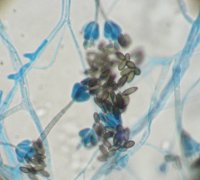I have a question regarding mould. Thank you first off for someone that is passionate about what you love to do; its great how much you share about all that you know. I’ve been contacted by a young lady that needs information. She lives in Vancouver, BC in a rancher home built in the late 80’s, or early 90’s and she is having mould problems. She just discovered on a window sill, a yellow golfball-sized fungus, that has orange dots on it. When she touched it to clean, it burst and had green goo inside. She has had a persistent cough for several months now and when she talked to the landlord about the fungus, plus black staining in the bathroom, he threatened to evict them, as he just told them that he will paint over it and not to bother him again.
Question: Just how much should they be concerned and/or how toxic is the mould? She is an employee of mine and she had approached me as of today of the incident(s). I thank you in advance for your time.
Answer: It’s hard to tell the type of mould and whether it’s toxigenic or not from the description only. However, all moulds are potentially a health hazard and should be removed (not painted over). The source of moisture that is promoting mould growth should be identified and corrected otherwise mould will continue growing. As for your employee, the best thing to do if the landlord is not willing to remove the mould is to move out or to seek help/advice from the public health department who may compel the landlord to remove the mould. Before reporting to any authority she should be sure that the mould is growing due to the landlord’s negligence and not her own lifestyle.

